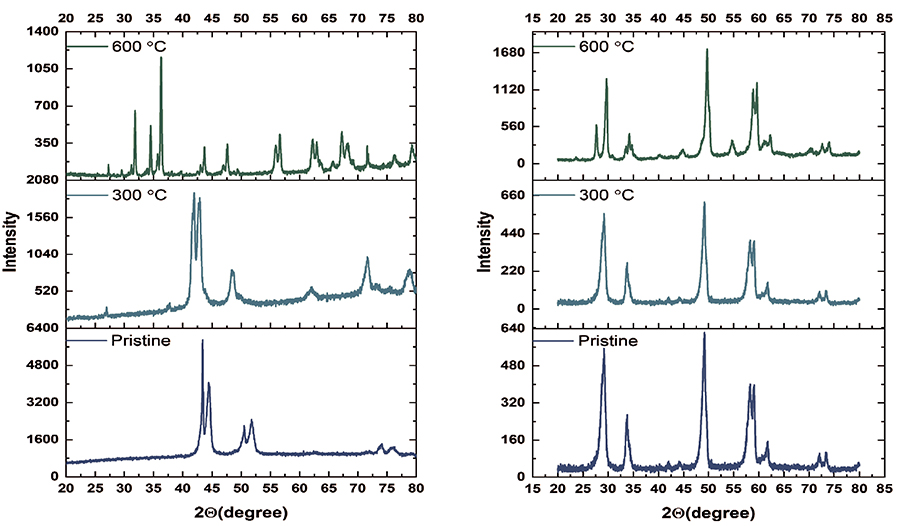X-Ray Diffraction
Represents stack plots of the Xray diffraction data on pristine and degraded samples for Metal (left) and Ceramic (Right).
The ceramic center post cartridges, as predicted by the authors, remained consistent in terms of the chemical composition (no sign of decomposition or chemical changes at 300 °C and 600 °C). On the contrary the metal sample undergoes a clear compositional change.
As can be seen by the XRD data, the ceramic samples reflect the structural integrity of the consistent composition. This is an indication of no change in crystal structure as the intensity and peak positions of the diffracting planes remain the same. Using rietveld refinement, we see in our XRD pattern the prominent tetragonal phase which is attributed to the (101) plane.

The XRD data also indicates that there is a slight monoclinic structure beginning to arise for the 600 °C sample due to the (111) plane at low angle 2θ. In calculating the mol% from the provided weight% (compositional data provided by Wonder Garden), it was determined that the Zirconia sample is 3 mol% Yttria doped Zirconia. When comparing the XRD pattern to the phase diagram we find that the data collected from XRD is consistent with the phases present in the phase diagram. The result from our XRD data suggests that Zirconia is a highly stable and unreactive material in these temperature ranges.
Witz Et al:Phase Evolution in Yttria-Stabilized Zirconia Thermal Barrier Coatings Studied by Rietveld Refinement of X-Ray Powder Diffraction Patterns.Journal of the American Ceramic Society.
■Table 1 – Composition of the Ceramic Centerpost
From the XRD data, it has been discovered that the metallic material is Brass. For the high temperature applications, it can be a regular choice but as discovered, the degradation happens a lot faster compared to the ceramic center-post. As can be seen in the plot at 600 °C (first plot on the left-hand side), the material undergoes drastic changes. At low angle 2θ, we believe the new peaks are attributed to the formation of ZnO (Zinc Oxide). At 300 °C for the brass sample (left XRD plot) we see that not much of a change has occurred in comparison to the pristine sample. The sample remained in good physical and chemical shape, lending to the materials stability from room temperature to 300 °C.


